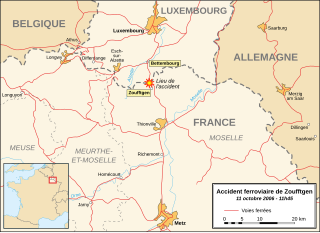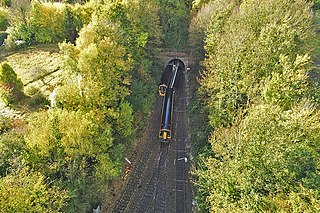Related Research Articles

The Quintinshill rail disaster was a multi-train rail crash which occurred on 22 May 1915 outside the Quintinshill signal box near Gretna Green in Dumfriesshire, Scotland. It resulted in the deaths of over 200 people and remains the worst rail disaster in British history.

The town of Morpeth in Northumberland, England, has what is reputed to be the tightest curve of any main railway line in Britain. The track turns approximately 98° from a northwesterly to an easterly direction immediately west of Morpeth Station on an otherwise fast section of the East Coast Main Line railway. This was a major factor in three serious derailments between 1969 and 1994. The curve has a permanent speed restriction of 50 miles per hour (80 km/h).

The Southall rail crash occurred on 19 September 1997, on the Great Western Main Line at Southall, West London. An InterCity 125 high speed passenger train (HST) failed to slow down in response to warning signals and collided with a freight train crossing its path, causing seven deaths and 139 injuries.

The Harmelen train disaster, on 8 January 1962, was the worst railway accident in the history of the Netherlands. Harmelen, in the central Netherlands, is the location of a railway junction where a branch to Amsterdam leaves the Rotterdam to Utrecht line. It is common at high-speed junctions to avoid the use of diamond crossings wherever possible—instead, a ladder crossing is employed where trains destined for the branch line cross over to the track normally employed for trains travelling in the opposite direction for a short distance before taking the branch line.
On February 8, 1986, in what is now part of Yellowhead County, Alberta, Canada, 23 people were killed in a collision between a Canadian National Railway freight train and a Via Rail passenger train called the Super Continental, including the engine crews of both trains. It was the deadliest rail disaster in Canada since the Dugald accident of 1947, which had 31 fatalities, and was not surpassed until the Lac-Mégantic rail disaster in 2013, which resulted in 47 deaths.

The Bellgrove rail accident occurred on 6 March 1989 when two passenger trains collided near Bellgrove station, Glasgow, United Kingdom. Two people were killed and 53 were injured. The cause was driver error, with a signal being passed at danger. The layout of a junction was a contributory factor.

The 2006 Zoufftgen train collision occurred around 11.45 am on 11 October 2006, near Zoufftgen, Moselle, France, some 20 metres from the border with Luxembourg, on the Metz–Luxembourg railway line. Two trains collided head-on while one track of a double track line was out of service for maintenance. Six people, including the drivers of both trains, were killed: two Luxembourgers and four French. Twenty more were injured in the collision, two seriously.

The Suonenjoki rail collision occurred on 12 August 1998, when a southbound VR InterCity train and a VR freight train arriving from the south collided south of the Suonenjoki railway station in Finland. Twenty-six people were injured, one of them seriously. The rear end of the locomotive of the freight train was thrusted high towards the air upon its first car.
The Sukkur rail disaster occurred on 4 January 1990 in the village of Sangi, near Sukkur in Sindh, Pakistan, claiming 307 lives. This makes it the deadliest rail accident in the country's history.
On 3 February 2003, a Comeng electric multiple unit train rolled away from Broadmeadows station in Melbourne, Australia, before it ran for nearly 17 kilometres (11 mi) out of control without a driver and eventually crashed into another train about to depart Spencer Street station. Train controllers attempted several times to stop or redirect the train, but were limited in their ability to intervene, instead being forced to alter the route of other trains to avert a more serious collision. Eleven people on board the stationary train were injured; authorities did not know until after the crash if any passengers were on board the runaway. An investigation identified driver error as the cause of the accident, but the runaway event prompted significant debate about the role of government authorities and private operators in ensuring safety and reliability on the Melbourne rail network.

The Salisbury Rail Crash was a railway accident on 31 October 2021, at Salisbury, Wiltshire, United Kingdom. Two trains, travelling on converging lines, collided at Salisbury Tunnel Junction, approximately one mile northeast of Salisbury railway station. Fourteen people, including one of the train drivers, were taken to hospital.
References
- 1 2 3 4 5 6 Leponiemi, Timo (3 March 2021). "15 evakkolasta kuoli, ja kuljettajasta jäi jäljelle vain rintaan palanut taskukello – sotasensuuri salasi Suomen tuhoisimmat junaturmat". Yle (in Finnish). Retrieved February 8, 2022.
- 1 2 Heino, Mikko (12 March 2016). "Kovan onnen rataosuus". Ilta-Sanomat (in Finnish). Sanoma. p. 40.
- 1 2 3 4 Koski, Sami (19 August 2021). "Kohtalokkaat torkut". Iltalehti (in Finnish). Alma Media . Retrieved February 8, 2022.